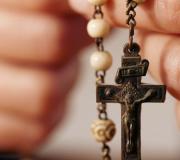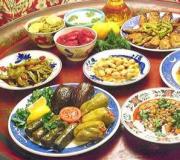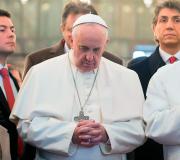Presentation on the topic "Dutch still life". Dutch still life XVII in Teacher of Fine Arts, Moscow Art Theater
MBUO "Novoobintsevskaya Secondary School"
The presentation was made by:
primary school teacher Nadezhda Vasilievna Kavylina

What is still life?
Still life (fr. nature morte -
“dead nature”) - the image of inanimate objects in the fine arts, in contrast to portrait, genre, historical and landscape themes.

Still life finally took shape as an independent genre of painting in the works of Dutch and Flemish artists of the 17th century. Objects in still life painting of this period often contain a hidden allegory - either of the transience of all earthly things and the inevitability of death (Vanitas), or - in a broader sense Passion of Christ and Resurrection. This is the meaning
transmitted through the use of objects - in most cases familiar and encountered in everyday life, which are endowed with additional symbolic meaning.

Flower still life
Since the 40s of the 17th century, still life in
Dutch painting became widespread as an independent genre. One of
the very first floral still life to stand out in
works by artists such as Ambrosius Bosshart the Elder And Balthasar van der Ast, And
still lifes of Jan Davids de Heem and his
followers already in the second half of the 17th century. The reasons for the popularity of floral still life can be
found in the everyday life of Dutch society - the tradition of having gardens, country villas
or indoor plants - as well as favorable natural conditions for the development of floriculture.

Scientist still life
Originated in university Leiden, the genre of “scientific” still life is called “vanity of vanities” or “memento mori” and is the most intellectual type of still life, requiring the viewer to know the Bible and the traditions of religious symbolism (typical paintings Peter Steenwijk and David Bayley). Often in still lifes of this direction there are illusionistic techniques that create a skillful optical illusion. In turn, the fascination with the illusionistic rendering of nature led to the emergence of a special type of still life - the so-called “trompe l’œil”. Such still lifes were especially common in the mid-17th century and gained incredible popularity in the country and abroad.

Dutch still life from the 17th century
The Dutch still life was
a unique cultural phenomenon of the 17th century that influenced the further development of the entire European
painting. "Little Dutch" reflected in their
works a world of objects living their own quiet, frozen life. The term "frozen life"
(Gol. stilleven, German stilleben, English still-life) became
used to denote the genre in the mid-17th century
century, initially in the Netherlands. Before this, artists called similar paintings when describing the plot:
“Little Breakfast”, “Bouquet of Flowers”, “Hunting Trophy”, “Vanity of Vanities”. Basic translation of the above
term found in literature - “quiet, motionless life.”

Still life in Russian painting 18th-20th centuries
Still life as an independent genre of painting appeared in Russia at the beginning of the 18th century. The idea of it was initially associated with the image of the gifts of the earth and the sea, the diverse world of things surrounding man.
Until the end of the 19th century, still life, in contrast to portraits and historical paintings, was considered as a “lower” genre. It existed mainly as an educational production and was accepted only in a limited understanding as painting of flowers and fruits.
The beginning of the twentieth century was marked by the heyday of Russian still life painting, which for the first time gained equality among other genres. The desire of artists to expand the possibilities of visual language was accompanied by active searches in the field of color, form, and composition. All this was especially clearly manifested in still life. Enriched with new themes, images and artistic techniques, Russian still life developed unusually rapidly: in a decade and a half it goes from impressionism to abstract form-making.
In the 30-40s of the twentieth century, this development stopped, but since the mid-50s, still life has experienced a new rise in Soviet painting and from that time on it finally and firmly stands on a par with other genres.
Presentation on the topic "Still Life" in fine arts in powerpoint format. This presentation for schoolchildren explains what still life is, its history and details about Dutch still life.
Fragments from the presentation
What is still life?
Still life- this is the image of inanimate objects in painting or graphics.
From the history of still life.
- Still life arose in the era of antiquity, but as an independent genre it began to develop only in the 17th century.
- Its heyday began in Holland, where the Reformation, by prohibiting artists from painting on religious themes, forced them to look for new directions.
Dutch still life
- In still lifes dating back to the early 17th century, objects are arranged in a strict order, like exhibits in a museum showcase. In such paintings, details are endowed with symbolic meaning. Apples are reminiscent of Adam's fall, and grapes are reminiscent of Christ's atoning sacrifice. A shell is a shell left behind by a creature that once lived in it; withered flowers are a symbol of death. A butterfly born from a cocoon means resurrection. Such are, for example, the paintings of Balthasar van der Ast.
- Dutch still life of the 17th century. amazes with its richness of themes. In every artistic center of the country, painters preferred their own compositions: in Utrecht - from flowers and fruits, in The Hague - from fish. In Haarlem they wrote modest breakfasts, in Amsterdam - luxurious desserts, and in the university of Leiden - books and other objects for studying science or traditional symbols of worldly vanity - a skull, a candle, an hourglass.
- For artists of the next generation, things no longer remind of abstract truths, but serve to create independent artistic images. In their paintings, familiar objects acquire a special, previously unnoticed beauty.
- Peter Klas subtly and skillfully emphasizes the uniqueness of each dish, glass, pot, finding the ideal neighborhood for any of them.
- In the still lifes of his fellow countryman Willem Claes Heda, picturesque disorder reigns. Most often he wrote “interrupted breakfasts.” A crumpled tablecloth, mixed up serving items, food that has barely been touched - everything here reminds of the recent presence of a person. The paintings are enlivened by diverse spots of light and multi-colored shadows on glass, metal, and canvas.
- In the second half of the 17th century. Dutch still life, like landscape, became more spectacular, complex and multicolored.
- The paintings of Abraham van Beijern and Willem Kalf depict grandiose pyramids of expensive dishes and exotic fruits.
Flemish school of painting
The Flemish artist Jan Veit's style is more refined than that of his teacher Snyders. Emphatically modest in composition and size, Feit’s works are interesting due to the harmony of restrained light, subtle shades of brown, greenish and light gray tones. This incomparable sensitivity of the painter brings him closer to the Dutch masters.
Description of the presentation by individual slides:
1 slide
Slide description:
2 slide
Slide description:
What is still life? Still life is the depiction of inanimate objects in painting or graphics.
3 slide
Slide description:
From the history of still life. Still life arose in the era of antiquity, but as an independent genre it began to develop only in the 17th century. Its heyday began in Holland, where the Reformation, by prohibiting artists from painting on religious themes, forced them to look for new directions. Frans Snyders. Flemish school. Fish shop.
4 slide
Slide description:
Dutch still life In still lifes dating back to the early 17th century, objects are arranged in a strict order, like exhibits in a museum showcase. In such paintings, details are endowed with symbolic meaning. Apples are reminiscent of Adam's fall, and grapes are reminiscent of Christ's atoning sacrifice. A shell is a shell left behind by a creature that once lived in it; withered flowers are a symbol of death. A butterfly born from a cocoon means resurrection. Such are, for example, the paintings of Balthasar van der Ast. Balthasar van der Ast. Still life with apple flowers
5 slide
Slide description:
Dutch still life of the 17th century. amazes with its richness of themes. In every artistic center of the country, painters preferred their own compositions: in Utrecht - from flowers and fruits, in The Hague - from fish. In Haarlem they wrote modest breakfasts, in Amsterdam - luxurious desserts, and in the university of Leiden - books and other objects for studying science or traditional symbols of worldly vanity - a skull, a candle, an hourglass. Peter Claes. Breakfast with ham.
6 slide
Slide description:
For artists of the next generation, things no longer remind of abstract truths, but serve to create independent artistic images. In their paintings, familiar objects acquire a special, previously unnoticed beauty. Peter Klas subtly and skillfully emphasizes the uniqueness of each dish, glass, pot, finding the ideal neighborhood for any of them. In the still lifes of his fellow countryman Willem Claes Heda, picturesque disorder reigns. Most often he wrote “interrupted breakfasts.” A crumpled tablecloth, mixed up serving items, food that has barely been touched - everything here reminds of the recent presence of a person. The paintings are enlivened by diverse spots of light and multi-colored shadows on glass, metal, and canvas. Willem Claes Heda. Breakfast with crab.
7 slide
Slide description:
In the second half of the 17th century. Dutch still life, like landscape, became more spectacular, complex and multicolored. The paintings of Abraham van Beijern and Willem Kalf depict grandiose pyramids of expensive dishes and exotic fruits. Willem Kalf. Dessert. About 1659
8 slide
Slide description:
Flemish School of Painting The manner of the Flemish artist Jan Veit is more refined than that of his teacher Snyders. Emphatically modest in composition and size, Feit’s works are interesting due to the harmony of restrained light, subtle shades of brown, greenish and light gray tones. This incomparable sensitivity of the painter brings him closer to the Dutch masters. Ian Faith. Still life with a dog.
still life
Dutch still life

Dutch still life
Along with landscape painting, still life, which was distinguished by its intimate character, became widespread in 17th-century Holland. Dutch artists chose a wide variety of objects for their still lifes, knew how to arrange them perfectly, and reveal the characteristics of each object and its inner life, inextricably linked with human life.

Willem Klaas Heda
Willem Klaas Heda
Willem Klaas Heda (1594 - 1680) was born in
Holland in Haarlem and studied painting with his
father of Gerrit Willem Hed. In Haarlem the artist
lived and worked all his life. He pursued a career as a painter
started with paintings on religious subjects and portraits
you, but then completely switched to writing
still lifes. Still life genre in Holland
The 17th century became widespread.
Willem Klaas Heda became one of the most important
significant representatives of this genre. He's like
Peter Klaas created modest "breakfasts" with
a simple set of uncomplicated objects.




Peter Klass
Pieter Claesz - 1597, Burgstein, Westphalia - 1661, Haarlem. Dutch painter. One of the first masters of Dutch still life in the 17th century. Studied with Floris van Dyck. From 1617 he worked in Haarlem. He mainly turned to the type of still life that was favorite in Holland, the so-called. “breakfasts” - an image of a laid table with a modest set of meal items and household utensils, arranged in seeming disorder (especially in early works), but subordinated to a thoughtful and clear (usually horizontal) composition. Each of the objects is located so that the viewer can perceive its texture, volume, and smallest details. Still lifes painted on a gray or olive background with soft diffused light are distinguished by a richness of shades within a single brownish-golden, silver-gray palette, hence their name - the genre of “monochrome breakfasts”.







Franz Snyders
France was born into the family of a wealthy Antwerp burgher in the fall of 1579). In his youth he studied with Pieter Bruegel the Younger and Hendrick van Balen (van Dyck's first teacher).
At first, the main theme of Snyders’s work was still lifes, but later he began to show greater interest in animalistic subjects and hunting scenes. Snyders' skill was highly appreciated by Peter Paul Rubens, who from 1613 invited him to collaborate on images of animals. At the same time, Snyders did not like to depict people - according to available information, the human figures in his paintings were painted by Jacob Jordaens, Abraham Janssens and other masters.














Andrian van Utrecht
He was apprenticed to Hermann de Rit in 1614 and later visited France, Italy and Germany before returning to Antwerp in 1625. He painted pantries with vegetables, farmyards with poultry, markets with fish, still lifes with fruits and vegetables. Pictures of playing cards are also often found in the work of Utrecht and reflect the influence of Frans Snyders.
Basically, all objects in the paintings of Utrecht are located on the line of the table.
Quirky details, such as a sweeping curtain and window image, add movement and depth.
Utrecht uses warm earthen tones, especially grey-greens, and strong chiaroscuro light, the latter of which may stem from his knowledge of Italian painting.





Wilem Kalf (1621 - 1693) is one of the most famous Dutch still life masters. In 1640 - 1645 he worked in France, from 1653 in Amsterdam, where Wilem Kalf subsequently lived. Being one of the greatest masters of the Dutch school of still life, Wilem Kalf painted both modestly based paintings depicting kitchens and backyards, and spectacular compositions with precious utensils and exotic southern fruits. Kalf's virtuosity as a still life painter was manifested in the classical precision of spatial constructions, a subtle sense of the originality and intrinsic value of each thing, in the sophistication and richness of light and colorful relationships in the spectacular comparison of various textures and materials.





Jan Davids de Heem
Jan Davids de Heem (1606 - 1684) Dutch
still life painter was born in Utrecht. He
student of Balthasar van der AstaHeed. In 1636 Jan Davids de Heem
moved to Antwerp, where he continued to work
living part of my life in the same genre
still life. His still lifes depicted
luxurious bouquets of flowers and large, graceful
laid tables.









Cornelis de Heem (1631 - 1695) a brilliant representative
body of Dutch-Flemish painting. He
born in Leiden, studied painting with his
father Jan Davids de Heem and was a member of the big
families of artists. Worked at Cornelis de Heem
Leiden, Antwerp, where from 1660 he was a member
Guild of Painters, as well as in The Hague. on his
still life scenes with fruits, metal
some dishes, glasses, books and music
with our instruments. The artist's works are stored
in many museums in Europe.




Balthasar van der Ast
Balthasar van der Ast is a Dutch artist and draftsman.
After his father's death in 1609, Balthasar moved in with his older sister Maria, who was married to Ambrosius Bosschaert the Elder. Van der Ast's early works clearly show the influence of Bosschaert.
Since 1619, Balthasar van der Ast lived in Utrecht, where he was admitted to the guild of St. Luke. It is assumed that Jan Davids de Hem studied with Asta.
Balthasar van der Ast died in December 1657 in Delft and was buried in the local church.









“Ordinary objects, unusual images” MHC lesson in high school
secondary school
Dear friends! Today we will take a trip to the Netherlands in the 17th century. and we will witness an important event in the history of culture - the
Dear friends! Today we will dotravel to the Netherlands in the 17th century. and we will become
witnesses of something important in the history of culture
events - the formation of a new genre of art.
15th century – the golden age of Dutch art
Great masters of the 17th century
Interest in the world of things in Antiquity
Frescoes - fragments of the walls of villas in Romeand Pompeii (50 BC-79 AD)
Franz Hals Still life - trompe l'oeil
Caravaggio. Christ at Emmaus.1606. Fragmet. National Gallery. London.
Caravaggio Fruit Basket. 1596-1597 Pinacoteca Ambrosiana. Milan.
K. Masseys. Portrait of a money changer with his wife. 1514. Louvre. Paris.
Interest in the world of things
What is still life?
Still life (French: nature morte, Italian:natura morta, literally - dead
nature; Dutch stilleven, German Stilleben,
English still life, literally - quiet or
still life), genre
fine arts (mainly
image of easel painting), which
dedicated to depicting things
located in a single environment and
organized into a group.
Still life – deceptive in its simplicity
In Ambrosius BosshartSenior at his work
"Flowers" in the center
depicts lily of the valley and
violet, stem
forget-me-nots, big
golden iris and two
tulip on the sides. IN
the picture shows two
world: earthly and heavenly
- window, sky and temple,
visible in the distance.
Flower still life
Decipher the still lifeone of the first
masters of still life
Ambrosio Balthazar
Vanitas
Vanitas – lat. "emptiness,futility, uselessness,
falsity,
vacuity"
Suppose they could
symbolize musical
tools in still life
Breakfast
"Luxurious" still lifes by Willem Kalf
Still lifes withprecious
utensils and
exquisite
dishes that
contemporaries
classified as
“luxurious”, more often
“read” by them
like a call to refuse
from excesses.
Markets and shops
PeterAersten
Snyders
"Meat
"Fish
shop"
shop" (1551)
Let's sum it up
In a still life, things are shown motionlessstate, they are in a conditional state
timeless space.
Things are given as if in close-up, they
seen up close and examined in detail.
Being voluntarily, consciously
arranged, still life always contains
contains a message, a secret letter
(cryptogram). Things turn into
symbols. Let's sum it up
The meanings of these symbols, the contents of messages
differs in great variety, but more often
of all is ideological and even
philosophical character.
At the end of the XVI-XVII centuries. Various
still life centers in the Netherlands. In business
bourgeois Haarlem - “breakfasts”, in
aristocratic Utrecht, long famous
growing flowers, - flower bouquets, in
port of The Hague - abundant fish compositions,
in Leiden (university town) - “scientists”
still lifes (so-called Vanitas,
dedicated to the frailty of life). Let's sum it up
Historical diversity
still lifes are determined by the fact that they
appear as specific
manifestation of artistic styles and
national schools in their historical
evolution.
The existence of classical still life
briefly - XVI-XVII centuries. Test yourself: which of the two slides
belongs to the vanitas genre?
Your journey to the 17th century Netherlands has come to an end. We hope that meeting with the wise and mysterious world of classical still life
Your journey has come to an endNetherlands of the 17th century. We hope that the meeting
with the wise and mysterious world of classical
You liked the still life. Kuznetsov,
Yu.N.. Social content of still life. –M.:
http://ec-dejavu.ru/n/Nature_morte.html
Flora http://scit.boom.ru/iskustvo/iskustvo_italii18.htm
and fauna, 1984
Still life
in European painting of the 16th and early 20th centuries.
http://art.1september.ru/articlef.php?
Catalog.
- M.: Soviet artist, 1976.
ID=200601602
Whipperhttp://www.vcc.ru/reshenie/2003-3/23
B.R. The problem and development of still life. – St. Petersburg, 2005.
Shcherbachev
M.I., Still life in Dutch painting. -L.,
http://bibliotekar.ru/kholland/8.htm
1945; http://www.psyho-study.com/study.php?
Kuznetsov
Yu. I., Western European still life. - L. - M.,
l=1&cat=1&file=15&page=4
1966;
Glozman I.M., On the history of Russian still life of the 18th century, in the book:
Russian art of the 18th century. Materials and research, M.,
1968, p. 53-71;
Author
Dimina Elena Viktorovna, seniorteacher of the history department,
teacher of MHC and cultural studies,




